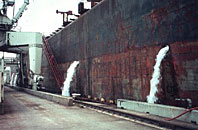 | |||||
 |
Policy and ManagementInvasive SpeciesAn invasive species is a species that does not naturally occur in a specific area and whose introduction does or is likely to cause economic or environmental harm or harm to human health. (executive order #13112) Has someone ever changed the television station while you were watching? Who was the person that did this to you? How did you feel? This person invaded your environment and never even asked for permission. People can be an invasive species. We control many aspects of our natural environment, one of them being the ocean. One way in which we disrupt the ecosystem is through the development of fisheries and large ports. People depend on the environment for food, livelihood and survival, but what are some of the effects of this human dependency on the ecosystem? One of the most common vectors of travel for invasive species is in ballast water. Ballast water is used to stabilize large transporter ships and is discharged at various points on their routes. When this water, containing a variety of species, is collected in their native ranges but discharged into non-native waters, it causes a disruption in the ecosystem. Many of these new species have arrived from other parts of the world and are a threat to the biology of our waters. They become marine invasive species whose actions are very hard to predict and control.  Ballast Water Discharging (Click for larger image) Invasive species are a form of biological pollution. They can be introduced from ballast water of ships, the side of foreign boats, swimmers' bodies or suits, airplane cargo, or imported fruits/vegetables/agricultural products, just to name a few. A recent study done at the Elkhorn Slough Monterey Bay National Estuarine Research Reserve looked at the difference between invasion rates of large estuaries with foreign shipping ports, and smaller estuaries without international shipping. They found that estuaries without international shipping are not safe from exotic invaders. In fact, they documented 55 exotic invertebrate invaders in the Slough (Wasson et al., 2000). Some exotic species were introduced from the early 1900s to the 1970s when oysters were cultured in the area. Researchers believe that most of the recent introduction into the Slough occurred indirectly through Monterey Bay, rather than directly from foreign waters. When the colonists arrived in New England over 300 years ago, significant changes to the landscape ensued. For the bird populations that utilized estuarine environments, many were displaced to different latitudinal zones. Cormorants and gulls moved to areas further north, whereas herons and egrets found habitats further south. The good news is that these bird species are returning to their former habitats. The bad news is that interactions between the species are causing concerns for local environmental managers. One example is with cormorants. Cormorants nest in the same habitat as herons and egrets, but cormorant guano is toxic to plants. By altering the habitat, cormorants are destroying the nesting habitat for the other species, and are taking over their niche in the ecosystem. Another example of a native species being influenced by human inhabitation is phragmites. A plant common in estuarine systems with brackish waters, phragmites have taken over the habitat previously occupied by other marsh grasses such as Spartina alterniflora. Whether through changes in tidal patterns caused by human impacts, or because of new genetic breeds migrating from Europe, phragmites are another headache for estuarine managers. In order to get a handle on the changes occurring in Rhode Island, a Rapid Bioassessment Monitoring Team has developed. The team of researchers spends several days at specific sites through Narragansett Bay, collecting baseline data on the all aspects of the environment. During their investigations, several new species have been discovered.
|
||||